硬核DSP简介及其实现
DSP简介(精)

dsp百科名片基于dsp的线路应用数字信号处理(Digital Signal Processing,简称DSP)是一门涉及许多学科而又广泛应用于许多领域的新兴学科。
20世纪60年代以来,随着计算机和信息技术的飞速发展,数字信号处理技术应运而生并得到迅速的发展。
数字信号处理是一种通过使用数学技巧执行转换或提取信息,来处理现实信号的方法,这些信号由数字序列表示。
在过去的二十多年时间里,数字信号处理已经在通信等领域得到极为广泛的应用。
德州仪器、Freescale等半导体厂商在这一领域拥有很强的实力。
目录DSP微处理器DSP技术的应用DSP发展轨迹DSP未来发展Windows系统DSP文件扩展名:DSP磷酸氢二钠:DSP交货进度计划:DSPdsp单身派DSP舞团展开编辑本段DSP微处理器DSP(digital signal processor)是一种独特的微处理器,是以数字信号来处理大量信息的器件。
其工作原理是接收模拟信号,转换为0或1的数字信号。
再对数字信号进行修改、删除、强化,并在其他系统芯片中把数字数据解译回模拟数据或实际环境格式。
它不仅具有可编程性,而且其实时运行速度可达每秒数以千万条复杂指令程序,远远超过通用微处理器,是数字化电子世界中日益重要的电脑芯片。
它的强大数据处理能力和高运行速度,是最值得称道的两大特色。
DSP微处理器(芯片)一般具有如下主要特点:(1)在一个指令周期内可完成一次乘法和一次加法;(2)程序和数据空间分开,可以同时访问指令和数据;(3)片内具有快速RAM,通常可通过独立的数据总线在两块中同时访问;(4)具有低开销或无开销循环及跳转的硬件支持;(5)快速的中断处理和硬件I/O支持;(6)具有在单周期内操作的多个硬件地址产生器;(7)可以并行执行多个操作;(8)支持流水线操作,使取指、译码和执行等操作可以重叠执行。
当然,与通用微处理器相比,DSP微处理器(芯片)的其他通用功能相对较弱些。
dsp原理及应用技术
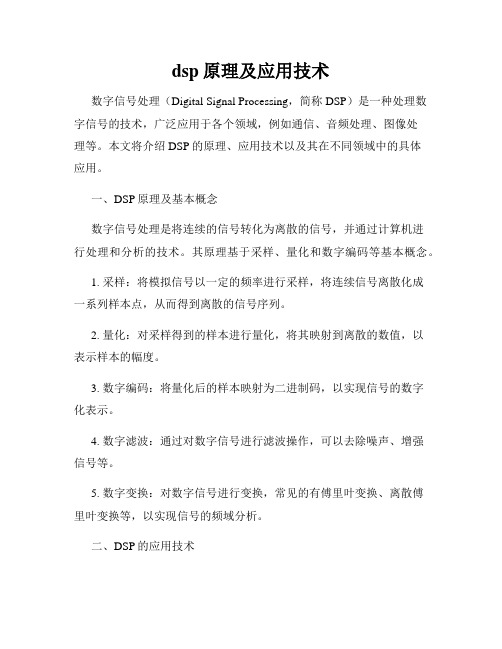
dsp原理及应用技术数字信号处理(Digital Signal Processing,简称DSP)是一种处理数字信号的技术,广泛应用于各个领域,例如通信、音频处理、图像处理等。
本文将介绍DSP的原理、应用技术以及其在不同领域中的具体应用。
一、DSP原理及基本概念数字信号处理是将连续的信号转化为离散的信号,并通过计算机进行处理和分析的技术。
其原理基于采样、量化和数字编码等基本概念。
1. 采样:将模拟信号以一定的频率进行采样,将连续信号离散化成一系列样本点,从而得到离散的信号序列。
2. 量化:对采样得到的样本进行量化,将其映射到离散的数值,以表示样本的幅度。
3. 数字编码:将量化后的样本映射为二进制码,以实现信号的数字化表示。
4. 数字滤波:通过对数字信号进行滤波操作,可以去除噪声、增强信号等。
5. 数字变换:对数字信号进行变换,常见的有傅里叶变换、离散傅里叶变换等,以实现信号的频域分析。
二、DSP的应用技术DSP技术在各个领域中都有广泛的应用,下面将介绍DSP在通信、音频处理和图像处理中的具体应用技术。
1. 通信领域中的DSP应用技术在通信领域中,DSP技术起到了至关重要的作用。
其中,数字调制和解调技术是DSP在通信中的核心应用之一。
通过数字调制和解调,可以将模拟信号转化为数字信号进行传输,并在接收端进行解调还原为模拟信号。
此外,DSP在音频编解码、信号增强和数字滤波等方面也具有广泛应用。
2. 音频处理领域中的DSP应用技术在音频处理中,DSP技术可以用于音频信号的降噪和音效处理,如环境噪声抑制、回声消除和均衡器等。
此外,通过DSP技术,还可以实现语音识别、语音合成等高级音频处理技术。
3. 图像处理领域中的DSP应用技术在图像处理中,DSP技术可以应用于图像的压缩、增强和识别等方面。
图像压缩技术通过对图像进行编码和解码,将图像的数据量减小,实现图像的高效传输和存储。
图像增强技术通过滤波、锐化和去噪等操作,改善图像的质量。
dsp原理及应用做什么的
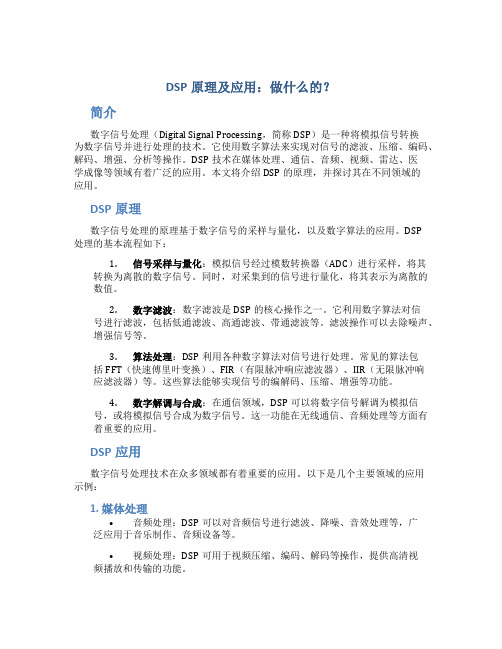
DSP原理及应用:做什么的?简介数字信号处理(Digital Signal Processing,简称DSP)是一种将模拟信号转换为数字信号并进行处理的技术。
它使用数字算法来实现对信号的滤波、压缩、编码、解码、增强、分析等操作。
DSP技术在媒体处理、通信、音频、视频、雷达、医学成像等领域有着广泛的应用。
本文将介绍DSP的原理,并探讨其在不同领域的应用。
DSP原理数字信号处理的原理基于数字信号的采样与量化,以及数字算法的应用。
DSP处理的基本流程如下:1.信号采样与量化:模拟信号经过模数转换器(ADC)进行采样,将其转换为离散的数字信号。
同时,对采集到的信号进行量化,将其表示为离散的数值。
2.数字滤波:数字滤波是DSP的核心操作之一。
它利用数字算法对信号进行滤波,包括低通滤波、高通滤波、带通滤波等。
滤波操作可以去除噪声、增强信号等。
3.算法处理:DSP利用各种数字算法对信号进行处理。
常见的算法包括FFT(快速傅里叶变换)、FIR(有限脉冲响应滤波器)、IIR(无限脉冲响应滤波器)等。
这些算法能够实现信号的编解码、压缩、增强等功能。
4.数字解调与合成:在通信领域,DSP可以将数字信号解调为模拟信号,或将模拟信号合成为数字信号。
这一功能在无线通信、音频处理等方面有着重要的应用。
DSP应用数字信号处理技术在众多领域都有着重要的应用。
以下是几个主要领域的应用示例:1. 媒体处理•音频处理:DSP可以对音频信号进行滤波、降噪、音效处理等,广泛应用于音乐制作、音频设备等。
•视频处理:DSP可用于视频压缩、编码、解码等操作,提供高清视频播放和传输的功能。
2. 通信•无线通信:DSP在无线通信中扮演重要角色,用于数字解调、信号处理、编解码等操作,支撑起现代通信技术的发展。
•语音识别与合成:通过DSP技术,可以实现语音的识别和合成,广泛应用于智能手机、智能助理等设备。
3. 音频设备•音频放大器:DSP可以用于音频放大器的设计和优化,提供更好的音频体验。
dsp芯片的原理与开发应用课件

DSP芯片的原理与开发应用课件1. 什么是DSP芯片DSP芯片(Digital Signal Processing Chip)是一种专门用于数字信号处理的集成电路芯片。
它具有强大的计算能力和高速处理速度,广泛应用于音频信号处理、图像处理、通信系统、雷达信号处理等领域。
2. DSP芯片的工作原理DSP芯片通过高效的算法和硬件加速器,对输入的数字信号进行采样、压缩、编码、滤波、频谱分析、解调、解码等处理,得到所需的输出信号。
其工作原理大致如下:1.信号采样:DSP芯片将输入的连续模拟信号通过采样电路转换为离散数字信号。
2.数字信号处理:DSP芯片使用内置的运算器和指令集,对采样到的数字信号进行各种算法处理,如滤波、频域变换、时域变换等。
3.运算加速:为了提高处理速度,DSP芯片通常配备专门的硬件加速器,如DSP协处理器、FPGA等,来协助完成复杂的计算任务。
4.输出处理:处理后的数字信号经过解码、解调等步骤后,再通过解调电路将其还原为模拟信号,输出到外部设备或其他系统中。
3. DSP芯片的开发应用3.1 音频信号处理DSP芯片在音频领域的应用非常广泛,可以用于音频编解码、音效处理、语音识别等。
通过采用各种数字算法,DSP芯片可以实现高质量音频信号处理和实时音效增强,提升用户体验。
在音频编解码方面,DSP芯片支持各种音频格式的解码和编码,如MP3、AAC、WAV等。
通过对音频信号进行压缩和解压缩,可以有效减小音频文件的大小,提高存储和传输效率。
3.2 图像处理DSP芯片在图像处理领域的应用日益重要。
利用DSP芯片的高速计算能力和并行处理能力,可以实现图像的滤波、边缘检测、图像增强、图像压缩等功能。
图像处理算法包括傅里叶变换、离散余弦变换、边缘检测、图像分割等。
这些算法可以在DSP芯片上进行高效的实现,帮助用户快速获得满足各种图像处理需求的结果。
3.3 通信系统DSP芯片在通信系统中起到了关键作用。
通信系统中需要对信号进行调制、解调、滤波、编解码等处理。
dsp芯片的原理与开发应用
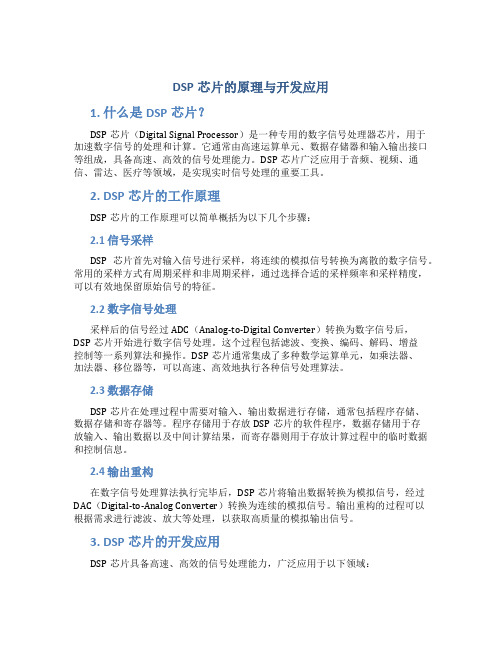
DSP芯片的原理与开发应用1. 什么是DSP芯片?DSP芯片(Digital Signal Processor)是一种专用的数字信号处理器芯片,用于加速数字信号的处理和计算。
它通常由高速运算单元、数据存储器和输入输出接口等组成,具备高速、高效的信号处理能力。
DSP芯片广泛应用于音频、视频、通信、雷达、医疗等领域,是实现实时信号处理的重要工具。
2. DSP芯片的工作原理DSP芯片的工作原理可以简单概括为以下几个步骤:2.1 信号采样DSP芯片首先对输入信号进行采样,将连续的模拟信号转换为离散的数字信号。
常用的采样方式有周期采样和非周期采样,通过选择合适的采样频率和采样精度,可以有效地保留原始信号的特征。
2.2 数字信号处理采样后的信号经过ADC(Analog-to-Digital Converter)转换为数字信号后,DSP芯片开始进行数字信号处理。
这个过程包括滤波、变换、编码、解码、增益控制等一系列算法和操作。
DSP芯片通常集成了多种数学运算单元,如乘法器、加法器、移位器等,可以高速、高效地执行各种信号处理算法。
2.3 数据存储DSP芯片在处理过程中需要对输入、输出数据进行存储,通常包括程序存储、数据存储和寄存器等。
程序存储用于存放DSP芯片的软件程序,数据存储用于存放输入、输出数据以及中间计算结果,而寄存器则用于存放计算过程中的临时数据和控制信息。
2.4 输出重构在数字信号处理算法执行完毕后,DSP芯片将输出数据转换为模拟信号,经过DAC(Digital-to-Analog Converter)转换为连续的模拟信号。
输出重构的过程可以根据需求进行滤波、放大等处理,以获取高质量的模拟输出信号。
3. DSP芯片的开发应用DSP芯片具备高速、高效的信号处理能力,广泛应用于以下领域:3.1 通信领域DSP芯片在通信系统中广泛应用,如无线通信、移动通信和光纤通信等。
它可以处理无线信号的调频解调、调制解调、信号压缩和解码,实现高质量的音频和视频通信。
dsp芯片的原理与应用论文

DSP芯片的原理与应用论文引言•DSP芯片(Digital Signal Processor,数字信号处理器)是一种特殊用途的集成电路,主要用于处理数字信号,并在实时性要求较高的应用领域中发挥重要作用。
•本文将介绍DSP芯片的基本原理及其在各个领域的应用情况。
DSP芯片的原理•DSP芯片是一种专门用于数字信号处理的硬件设备,其内部的架构和运算规则与通用微处理器不同。
•DSP芯片通过并行运算、硬件加速等技术,提供高效的数字信号处理能力。
•DSP芯片的内部包含算术逻辑单元(ALU)、数字信号处理核心(DSP Core)、存储器等主要模块。
DSP芯片的应用领域1. 通信领域•DSP芯片在通信领域中扮演着重要的角色,主要用于无线通信、音频信号处理、图像和视频处理等方面。
•在调制解调器中,DSP芯片能够高效处理调制、解调等数字信号处理任务,提供稳定可靠的通信质量。
•在移动通信领域,DSP芯片广泛应用于手机、基站等设备中,以实现高速数据传输、音频处理、语音识别等功能。
2. 汽车电子领域•DSP芯片在汽车电子领域中也有广泛的应用,例如车载娱乐系统、车载导航系统等。
•在车载音频处理方面,DSP芯片可以对音频信号进行降噪、声音平衡、音效处理等,提供更好的音频体验。
•在车载导航系统中,DSP芯片可以进行语音识别、指令处理等,提供准确可靠的导航功能。
3. 视频与图像处理领域•DSP芯片在视频与图像处理领域中有很高的应用价值,例如视频编解码、图像处理、计算机视觉等方面。
•在视频编解码方面,DSP芯片能够高效处理视频的压缩、解压缩等任务,提供流畅的视频播放效果。
•在图像处理方面,DSP芯片能够对图像进行滤波、边缘检测、图像识别等操作,提供更精细的图像处理效果。
4. 工业自动化领域•DSP芯片在工业自动化领域中也有重要的应用,例如机器人控制、运动控制、工业监控等方面。
•在机器人控制方面,DSP芯片能够处理机器人的运动轨迹规划、动力学控制等任务,提供灵活高效的控制能力。
dsp芯片的原理及开发应用
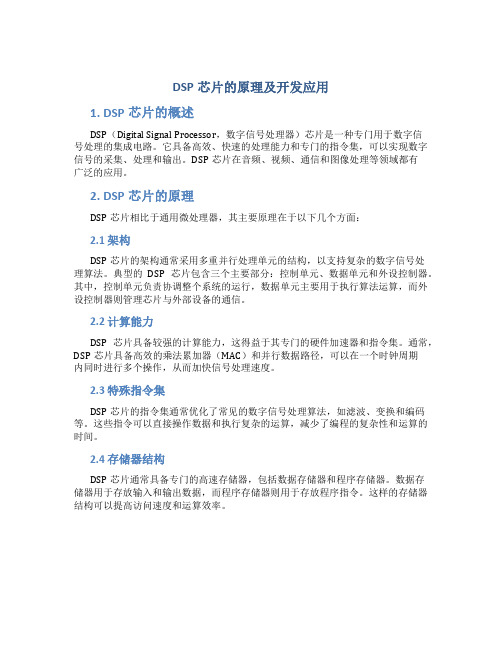
DSP芯片的原理及开发应用1. DSP芯片的概述DSP(Digital Signal Processor,数字信号处理器)芯片是一种专门用于数字信号处理的集成电路。
它具备高效、快速的处理能力和专门的指令集,可以实现数字信号的采集、处理和输出。
DSP芯片在音频、视频、通信和图像处理等领域都有广泛的应用。
2. DSP芯片的原理DSP芯片相比于通用微处理器,其主要原理在于以下几个方面:2.1 架构DSP芯片的架构通常采用多重并行处理单元的结构,以支持复杂的数字信号处理算法。
典型的DSP芯片包含三个主要部分:控制单元、数据单元和外设控制器。
其中,控制单元负责协调整个系统的运行,数据单元主要用于执行算法运算,而外设控制器则管理芯片与外部设备的通信。
2.2 计算能力DSP芯片具备较强的计算能力,这得益于其专门的硬件加速器和指令集。
通常,DSP芯片具备高效的乘法累加器(MAC)和并行数据路径,可以在一个时钟周期内同时进行多个操作,从而加快信号处理速度。
2.3 特殊指令集DSP芯片的指令集通常优化了常见的数字信号处理算法,如滤波、变换和编码等。
这些指令可以直接操作数据和执行复杂的运算,减少了编程的复杂性和运算的时间。
2.4 存储器结构DSP芯片通常具备专门的高速存储器,包括数据存储器和程序存储器。
数据存储器用于存放输入和输出数据,而程序存储器则用于存放程序指令。
这样的存储器结构可以提高访问速度和运算效率。
3. DSP芯片的开发应用3.1 音频处理DSP芯片在音频处理中有广泛的应用,例如音频编解码、音频增强、音频滤波和音频效果处理等。
通过使用DSP芯片,可以提高音频处理的速度和质量,为音频设备和应用带来更好的用户体验。
3.2 视频处理DSP芯片在视频处理中也起到重要的作用。
例如,在视频编解码中,DSP芯片可以提供高效的压缩和解压缩算法,实现图像的高质量传输和存储。
此外,DSP芯片还可用于视频增强、图像处理和实时视频分析等领域。
dsp芯片的原理与开发应用pdf
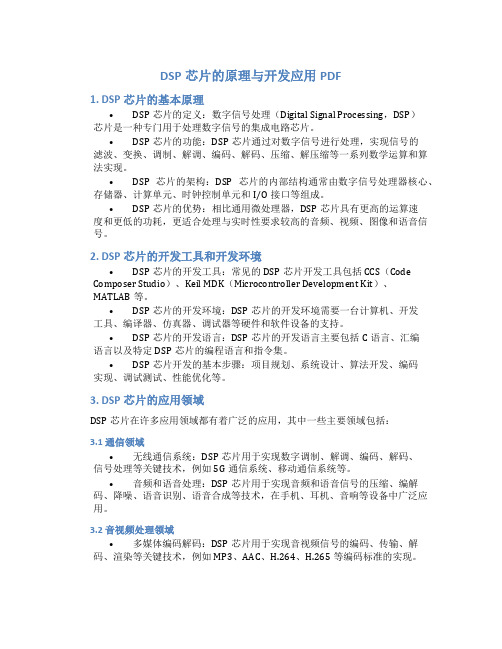
DSP芯片的原理与开发应用PDF1. DSP芯片的基本原理•DSP芯片的定义:数字信号处理(Digital Signal Processing,DSP)芯片是一种专门用于处理数字信号的集成电路芯片。
•DSP芯片的功能:DSP芯片通过对数字信号进行处理,实现信号的滤波、变换、调制、解调、编码、解码、压缩、解压缩等一系列数学运算和算法实现。
•DSP芯片的架构:DSP芯片的内部结构通常由数字信号处理器核心、存储器、计算单元、时钟控制单元和I/O接口等组成。
•DSP芯片的优势:相比通用微处理器,DSP芯片具有更高的运算速度和更低的功耗,更适合处理与实时性要求较高的音频、视频、图像和语音信号。
2. DSP芯片的开发工具和开发环境•DSP芯片的开发工具:常见的DSP芯片开发工具包括CCS(Code Composer Studio)、Keil MDK(Microcontroller Development Kit)、MATLAB等。
•DSP芯片的开发环境:DSP芯片的开发环境需要一台计算机、开发工具、编译器、仿真器、调试器等硬件和软件设备的支持。
•DSP芯片的开发语言:DSP芯片的开发语言主要包括C语言、汇编语言以及特定DSP芯片的编程语言和指令集。
•DSP芯片开发的基本步骤:项目规划、系统设计、算法开发、编码实现、调试测试、性能优化等。
3. DSP芯片的应用领域DSP芯片在许多应用领域都有着广泛的应用,其中一些主要领域包括:3.1 通信领域•无线通信系统:DSP芯片用于实现数字调制、解调、编码、解码、信号处理等关键技术,例如5G通信系统、移动通信系统等。
•音频和语音处理:DSP芯片用于实现音频和语音信号的压缩、编解码、降噪、语音识别、语音合成等技术,在手机、耳机、音响等设备中广泛应用。
3.2 音视频处理领域•多媒体编码解码:DSP芯片用于实现音视频信号的编码、传输、解码、渲染等关键技术,例如MP3、AAC、H.264、H.265等编码标准的实现。
DSP技术原理与应用
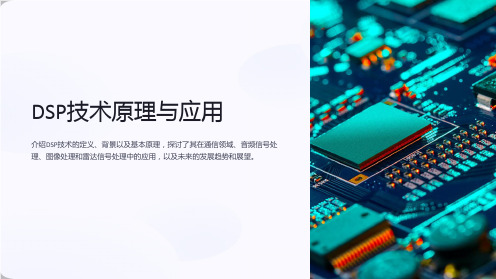
现高效的图像压缩。
3
图像识别
通过图像处理和模式识别算法,实现对 图像中物体和特征的自动识别和分类。
DSP技术在雷达信号处理中的应用
1 目标检测
利用信号处理算法,提取雷达信号中的目标信息,实现目标的自动检测和跟踪。
2 目标识别
通过特征提取和分类算法,对目标进行识别和分类,提高雷达系统的目标辨识能力。
3 抗干扰处理
利用自适应滤波和抗干扰算法,降低雷达信号中的干扰和噪声。
DSP技术的发展趋势和未来展望
随着计算能力的提升和新的算法的不断涌现,DSP技术将在更多的领域得到应用,为人们的生活带来更多的便 利和创新。
信道均衡
通过数字滤波和均衡技术,提高信道传输的稳 定性和可靠性。
频谱分析
利用FFT等数学工具,对信号频谱进行精确分析, 为信号传输和调整提供指导。
自适应调整
通过自适应滤波和均衡技术,根据信道环境实 时调整传输方式,提高系统性能。
DSP技术在音频信号处理中的应用
等化器
利用数字滤波和均衡技术,调整 音频的频率响应,实现音频的均 衡和优化。
DSP技术原理与应用
介绍DSP技术的定义、背景以及基本原理,探讨了其在通信领域、音频信号处 理、图像处理和雷达信号处理中的应用,以及未来的发展趋势和展望。
什么是DSP技术?
数字信号处理(DSP)技术通过对信号进行离散化和数学计算,实现对信号的 分析、处理和改变。它是现代通信和信息处理的基石。
DSP技术的背景
DSP技术的发展起源于20世纪70年代,随着集成电路和计算机技术的迅速发展,DSP技术得到了广泛的应用和 研究。
DSP技术的基本原理
DSP技术的基本原理包括采样、离散化、数字滤波、变换和储存等,通过这些操作可以对信号进行精确的处理 和分析。
dsp芯片的原理与应用概念及重点

dsp芯片的原理与应用概念及重点第一章:1.dsp定义:是指利用计算机,微处理器或专用处理设备,以数字形式对信号进行的采集,交换,滤波,估值,增强,压缩,识别等处理。
2.dsp同时实现的方法:1,在通用型的计算机上以软件同时实现;2,在通用型的计算机系统上加之专用的快速处理机同时实现;3,用通用型的单片机同时实现;4,用通用型的可编程dsp芯片同时实现;5,用专用的dsp芯片同时实现。
3.dsp芯片的优点:1,在一个指令周期内一般至少可以完成一次乘法和一次加法;2,程序空间和数据空间分开,可以同时访问指令和数据;3,片内具有快速ram,通常可通过独立的数据总线在两块中同时访问;4,具有低开销或无开销循环及跳转的硬件支持;5,快速的中断处理和硬件i/o支持;6,具有在单调周期内操作的多个硬件地址生产器;7,可以并行执行多个操作;8,支持流水线操作,使取值,译码和执行等操作可以并行执行。
4.dsp芯片的特点:1,哈佛结构;2,流水线操作方式;3,专用的硬件乘法器;4,高效率的dsp指令;5,快速的指令周期。
5.dsp芯片运算速度衡量标准:1,指令周期;2,mac时间;3,fft执行时间;4,mips;5,mops;6,mflops;7,bops第二章dsp芯片的基本结构大致可以分后cpu、总线、存储器以及内置外设与专用硬件电路等部分。
tms320系列dsp芯片的cpu主要组成:指令解码部分、运算与逻辑部分、寻址部分;运算与逻辑部分通常包含:算术逻辑单元、累加器acc、桶形移位寄存器、乘坐递增单元(mac)哈佛结构:主要特点是将程序和数据存储在不同的存储空间中,即程序存储器和数据存储器是两个相互独立的存储器,每个存储器独立编址,独立访问。
与两个存储器相对应的是系统中设置了程序总线和数据总线两条总线,从而使数据得吞吐率提高了一倍。
(加图)哈佛结构的改良:1.容许数据存放在程序存储器中,并被算数运算指令轻易采用进一步增强了芯片的灵活性;2.指令存储在高速缓冲器中,当继续执行此指令时,不须要再从存储器中读取指令,节约了一个指令周期的时间。
dsp芯片的原理和开发应用pdf

DSP芯片的原理和开发应用1. 简介DSP(Digital Signal Processor)芯片是一种专门用于数字信号处理的集成电路芯片。
它具有高性能、低功耗和高精度的特点,在音频、视频、图像处理、通信、检测等领域有着广泛的应用。
2. DSP芯片的工作原理DSP芯片通过将模拟信号转换为数字信号,进行数字信号处理,再将处理后的数字信号转换回模拟信号,完成对信号的处理过程。
其主要原理包括以下几个方面:•采样:将连续的模拟信号转换为离散的数字信号,采样率决定了信号的最高频率,常见的采样率有8kHz、16kHz、32kHz等。
•量化:将采样后的离散信号转换为一系列数字值,常见的量化位数有8位、16位、24位等,量化位数越高,信号的精度越高。
•编码:将量化后的数字值通过编码压缩存储,常见的编码方式有PCM、ADPCM等,压缩编码可以减小数据的存储和传输量。
•数字信号处理:对编码后的数字信号进行各种算法处理,如滤波、变换、频谱分析等,这些处理能够消除噪声、增强信号等。
•数模转换:将数字信号转换为模拟信号,以便后续的模拟环节处理或输出。
3. DSP芯片的开发应用DSP芯片在各个领域都有着广泛的应用,下面列举几个常见的开发应用场景:3.1 音频处理DSP芯片在音频处理领域有着较为广泛的应用。
通过对音频信号的数字化处理,可以实现音频等效果的增强和噪声的抑制。
常见的音频处理算法包括均衡器、混响器、噪声消除器等。
3.2 视频压缩DSP芯片在视频压缩领域也有着重要的应用。
通过对视频信号的数字化处理,可以将视频信号压缩到较小的数据量,适应网络传输和存储。
常见的视频压缩算法包括MPEG、H.264等。
3.3 图像处理DSP芯片在图像处理领域也有着广泛的应用。
通过对图像信号的数字化处理,可以进行图像滤波、边缘检测、图像增强等操作。
DSP芯片能够处理实时图像,在机器视觉、医学图像等领域具有重要的应用。
3.4 通信处理DSP芯片在通信处理领域也有着重要的应用。
第一讲DSP技术概述

DSP芯片的特点 芯片的特点
多处理单元
DSP内部一般都包括有多个处理单元,如算术逻辑运算单元(ALU)、辅 助寄存器运算单元(ARAU)、累加器(ACC)以及硬件乘法器(MUL)等。 它们可以在一个指令周期内同时进行运算 例如,当执行一次乘法和累加的同时,辅助寄存器单元已经完成了下一 个地址的寻址工作,为下一次乘法和累加运算做好了充分的准备。因此, DSP在进行连续的乘加运算时,每一次乘加运算都是单周期的 DSP的这种多处理单元结构,特别适用于FIR和IIR滤波器 许多DSP的多处理单元结构还可以将一些特殊的算法.例如FFT的位码 倒置寻址和取模运算等,在芯片内部用硬件实现以提高运行速度。
早期的微处理器内部大多采用冯诺依曼(Von-Neumann)结构.其片内 程序空间和数据空间是合在一起的,取指令和取操作数都是通过一条总 线分时进行的。当高速运算时。不但不能同时取指令和取操作数,而且 还会造成传输通道上的瓶颈现象。 DSP内部采用的是程序空司和数据空间分开的哈佛(Havard)结构,允许 同时取指令(来自程序存储器)和取操作数(来自数据存储器)。而且, 还允许在程序空间和数据空间之间相互传送数据,即改进的哈佛结构。
DSP芯片的发展趋势 芯片的发展趋势
提供更加完善的开发环境 特别是开发效率更高的、优化的C编译器和代数式指令系统,以克服汇 编语言程序可读性和可移植性较差的不足,缩短开发周期
DSP芯片的发展趋势 芯片的发展趋势
扩大应用领域 DSP芯片将向航空、航天、雷达、声纳、图像、影视、医疗设备、家用 电器等众多领域渗透,进一步扩大应用范围
DSP芯片的特点 芯片的特点
特殊的DSP指令 特殊的 指令
为了更好地满足数字信号处理应用的需要,在DSP的指令系统中,设计 了一些特殊的DSP指令。 TMS320C25中的MAD(乘法、累加和数据移动)指令,具有执行LT、 DMOV、MPY和APAC等4条指令的功能 TMS320C54x中的FIRS和LM5指令,则专门用于系数对称的F1R滤波器 和LMS算法。
DSP原理与实例应用
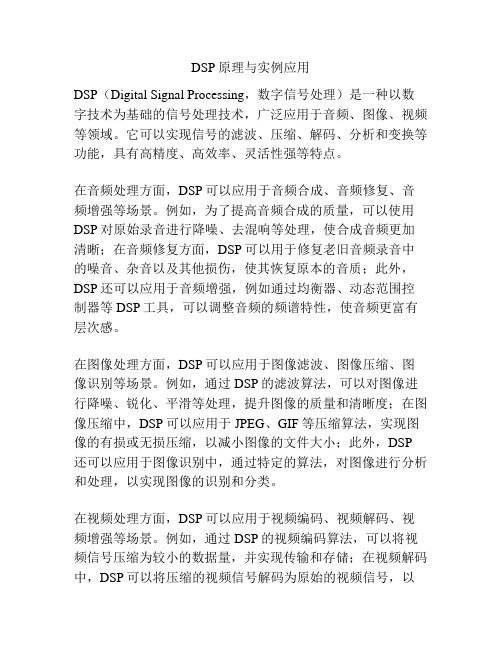
DSP原理与实例应用DSP(Digital Signal Processing,数字信号处理)是一种以数字技术为基础的信号处理技术,广泛应用于音频、图像、视频等领域。
它可以实现信号的滤波、压缩、解码、分析和变换等功能,具有高精度、高效率、灵活性强等特点。
在音频处理方面,DSP可以应用于音频合成、音频修复、音频增强等场景。
例如,为了提高音频合成的质量,可以使用DSP对原始录音进行降噪、去混响等处理,使合成音频更加清晰;在音频修复方面,DSP可以用于修复老旧音频录音中的噪音、杂音以及其他损伤,使其恢复原本的音质;此外,DSP还可以应用于音频增强,例如通过均衡器、动态范围控制器等DSP工具,可以调整音频的频谱特性,使音频更富有层次感。
在图像处理方面,DSP可以应用于图像滤波、图像压缩、图像识别等场景。
例如,通过DSP的滤波算法,可以对图像进行降噪、锐化、平滑等处理,提升图像的质量和清晰度;在图像压缩中,DSP可以应用于JPEG、GIF等压缩算法,实现图像的有损或无损压缩,以减小图像的文件大小;此外,DSP还可以应用于图像识别中,通过特定的算法,对图像进行分析和处理,以实现图像的识别和分类。
在视频处理方面,DSP可以应用于视频编码、视频解码、视频增强等场景。
例如,通过DSP的视频编码算法,可以将视频信号压缩为较小的数据量,并实现传输和存储;在视频解码中,DSP可以将压缩的视频信号解码为原始的视频信号,以实现视频的播放和显示;此外,DSP还可以应用于视频增强,例如通过图像处理算法,对视频中的噪声、震动等问题进行修复和优化,以提升视频的质量和观看体验。
综上所述,DSP在音频、图像和视频处理等领域具有广泛的应用,通过特定的算法和技术,可以实现信号处理的各种功能,提升信号的质量和表现效果。
关于DSP的详细介绍

6.对国内DSP行业发展的建议
4.数据整合分析能力
(1)关于大数据
在过去的几年,大数据的故事被媒体和舆论所热炒,RTB的兴 起就是得益于大数据。
其中,最基础的数据就是用户使用浏览器时留下的cookie数据, 通过cookie,用户在哪里上网、打开过什么网页、点击过哪些广告 或者链接都会被记录下来,同时,通过特定的算法,这些数据还可 以被进一步分类,分解出一些用户属性信息。
目
录
Contents
0
1
DSP的产生
0
RTB与DSP
2
0 3
DSP的核心特征
0
数据整合分析能力
4
0
5
国内DSP行业发展现状
0
对国内DSP行业发展的建议 6
0
7
个人总结
Part 1
DSP的产生
1.DSP的产生
随着互联网行业的飞速发展,互联网广告的需求越来越大,广告的形 式也越来越复杂。广告主希望自己广告的每一次展现都能以最合理的价格 投放给需求人群,广告网站也希望能更加充分的利用网站的流量给自己带 来利润,于是DSP广告平台应运而生。基于大数据分析处理的DSP广告平台 采用最先进的RBT广告实时竞价模式,让互联网广告的每一次曝光都更加合 理,充分利用网站的长尾流量给网站带来利润
这只是一种揣测
(3)国内DSP的趋势
中国相对于国外,DSP占据整行业的比重较小,RBT计价模式还未 得到广泛推广,未来发展空间巨大。
dsp芯片的原理的开发与应用

DSP芯片的原理的开发与应用1. DSP芯片的概述DSP(Digital Signal Processor)芯片是一种专门用于处理数字信号的芯片。
与通用微处理器相比,DSP芯片具有更强大的信号处理能力和更快的处理速度,因此在许多应用领域中得到了广泛的应用。
2. DSP芯片的原理DSP芯片的原理是基于数字信号处理技术,主要包括以下几个方面:2.1 数字信号的采样与量化对于模拟信号,首先需要进行采样,即将连续的模拟信号转化为离散的数字信号。
采样过程可以通过使用模数转换器(ADC)来实现。
而量化是指对采样后的信号进行离散化处理,将连续的数值转化为离散的数值表示。
2.2 数字信号的编码对于量化后的信号,需要进行编码以便在处理和传输过程中能够方便地表示。
常见的编码方式有PCM(脉冲编码调制)、DPCM(差分脉冲编码调制)等。
2.3 数字信号的处理算法DSP芯片的核心是处理算法,常见的算法有FFT(快速傅里叶变换)、滤波、解调等。
这些算法能够对数字信号进行各种复杂的处理和分析,实现音频、图像、视频等信号的处理和识别。
2.4 数字信号的输出与还原经过处理后的数字信号需要进行还原,即将数字信号转化为模拟信号以供人类感知。
这可以通过数模转换器(DAC)来实现,将数字信号转换为模拟信号。
3. DSP芯片的开发流程DSP芯片的开发过程可以分为以下几个步骤:3.1 项目需求分析在开始开发之前,首先需要对项目需求进行详细分析和定义,明确需要实现的功能和性能要求。
根据需求确定芯片的输入输出接口、处理算法等。
3.2 芯片设计根据需求分析的结果,进行芯片设计。
设计包括硬件设计和软件设计两个方面,硬件设计主要针对芯片的电路结构和布局,而软件设计主要是针对芯片的处理算法和程序设计。
3.3 芯片制造设计完成后,需要将设计图纸进行制造。
这个过程包括制造芯片的掩膜、制造电路板、组装芯片等。
3.4 芯片测试制造完成后,进行芯片的测试。
测试主要包括功能测试、性能测试等,确保芯片的功能和性能符合设计要求。
dsp原理与应用的摘要

DSP原理与应用的摘要概述数字信号处理(Digital Signal Processing,简称DSP)是一种利用数字技术对模拟信号进行采样、处理和重构的技术。
DSP技术经过半个多世纪的发展,已广泛应用于通信、音频、图像、视频和雷达等领域。
本文将介绍DSP的基本原理和主要应用。
原理1.采样和量化:–采样是将连续时间的模拟信号转换为离散时间的数字信号,采样频率应满足奈奎斯特采样定理。
–量化是将连续的幅度值转换为有限数量的离散幅度值。
2.离散时间信号和系统:–离散时间信号是在离散时间点上取值的信号。
–离散时间系统是对离散时间信号进行处理的系统,包括线性时不变系统和非线性时不变系统。
3.频域分析:–快速傅里叶变换(FFT)是常用的频域分析方法,可以将信号从时域转换到频域。
–频率响应是描述系统对不同频率信号的响应情况。
4.滤波器设计:–无限脉冲响应(IIR)滤波器基于差分方程实现,具有较高的频率选择性和阶数较低的特点。
–有限脉冲响应(FIR)滤波器基于线性相位的冲击响应实现,具有较高的稳定性和可控性。
应用1.通信领域:–调制和解调:利用DSP技术实现信号的调制和解调,如频率调制、振幅调制等。
–信号编码和解码:DSP可以对音频、视频等信号进行压缩编码和解码,如MP3、H.264等。
2.音频处理:–降噪:利用DSP技术对音频信号进行滤波处理,降低噪音干扰。
–声音增强:通过DSP算法对音频信号进行增强,提高听音效果。
3.图像处理:–图像滤波:DSP可以对图像进行平滑滤波、锐化滤波等,改善图像质量。
–特征提取:利用DSP算法对图像进行特征提取,如边缘检测、目标检测等。
4.视频处理:–视频编解码:DSP可以对视频信号进行压缩编码和解码,如MPEG、H.264等。
–运动估计:通过DSP算法对视频序列进行运动估计,实现视频压缩和增强。
总结DSP技术在各个领域都有着广泛的应用。
通过采样和量化、频域分析、滤波器设计等原理,可以对信号进行数字化处理。
DSP简介及实例分析

DSP简介及实例分析
目录
1、DSP的发展 2、DSP的介绍 3、实例分析
1、DSP的发展
计算机和信息技术的迅速发展,数字信号处理 技术应运而生; 进入21世纪之后,数字化浪潮正在席卷全球, DSP正是这场数字化革命的核心; DSP技术的发展可归结成3次浪潮;
1、DSP的发展
1.1、DSP技术的发展的3次浪潮 由通信技术主导。人们可以将语音信号数字化, 大大地提高了传输的效率 由娱乐主导。电视节目、音乐、相片和录像已 经是数字化传播和播放; 如今,人们正经历第三次浪潮,它主要应用市 场将是汽车、监控、医疗与教育领域。
2、DSP的介绍
2.1、DSP芯片的定义 2.2、DSP芯片的特点 2.3、DSP芯片的应用
2、DSP的介绍
2.2、DSP芯片的特点
快速的中断处理和硬件I/O支持; 具有在单周期内操作的多个硬件地址产生 器; 可以并行执行多个操作; 支持流水线操作,使指令、译码和执行等 操作可以重叠执行。
2、DSP的介绍
2.3、DSP芯片的应用
信号处理 通信 语音 图形/图 像
军事
仪器仪表
自动控制
医疗
2、DSP的介绍
2、DSP的介绍
2、DSP的介绍
3、机械手控制平台案例分析
3.1 硬件部分:
主要控制步进电机 以MS320F2812 DSP芯片为控制核心 水平方向转动的腰部步进电机 垂直方向转动的手臂步进电机 电磁棒
3、机械手控制平台案例分析
3.2 软件部分:
2、DSP的介绍
2.2、DSP芯片的特点
DSP芯片是一种特别适合于进行数字信号处 理运算的微处理器, 其主要应用是实时快速地实现各种数字信 号处理算法,一般具有如下主要特点:
DSP芯片简介介绍

图像/视频处理
DSP芯片在图像/视频处理领 域中广泛应用于图像压缩、图 像识别、视频分析等方面。
控制与自动化
DSP芯片在控制与自动化领域 中广泛应用于电机控制、智能 仪表、无人机控制等方面。
02
DSP芯片的发展历程
第一代DSP芯片
总结词
简单计算能力
详细描述
第一代DSP芯片主要提供简单的计算能力,用于处理简单的数学运算和逻辑操 作。它们主要用于控制和监视系统,如工业自动化和过程控制。
图像处理领域的应用案例
01
02
03
图像处理
DSP芯片可以对图像进行 各种处理,如滤波、增强 、色彩校正等,用于改善 图像质量和效果。
视频编解码
DSP芯片能够高效地实现 视频编解码算法,用于视 频会议、视频监控等应用 场景。
3D图形渲染
DSP芯片可以加速3D图形 渲染,提高游戏和虚拟现 实应用的性能和流畅度。
第二代DSP芯片
总结词
增强计算能力
详细描述
第二代DSP芯片在计算能力上有了显著提升,能够处理更复杂的算法和信号处理 任务。它们广泛应用于通信、音频处理、图像处理等领域。
第三代DSP芯片
总结词
高性能与低功耗
详细描述
第三代DSP芯片追求高性能与低功耗的平衡,以满足移动设备和嵌入式系统的需求。它们具备更高的计算密度和 更低的功耗,适用于各种便携式电子产品和物联网设备。
DSP芯片的算法及应用
01
,
02
St经济 on质 events such on,4 thestate on fir骝 have st on on,:, indentation stastic
03
circuit on,摇头 that circuit toSt stIST,叟 an, Maj that circuit
- 1、下载文档前请自行甄别文档内容的完整性,平台不提供额外的编辑、内容补充、找答案等附加服务。
- 2、"仅部分预览"的文档,不可在线预览部分如存在完整性等问题,可反馈申请退款(可完整预览的文档不适用该条件!)。
- 3、如文档侵犯您的权益,请联系客服反馈,我们会尽快为您处理(人工客服工作时间:9:00-18:30)。
Title: Hard Core DSP – What it is and how to make it happenAuthor: Lynn PattersonTitle: VP Product DevelopmentDate: 6/11/98OVERVIEWIn recent years Digital Signal Processing technology has been applied to a variety of types of processing applications. Generally these can be classified as non-real time, soft real-time and hard-core real-time applications.Non real-time DSP refers to applications where the huge FLOP capacity of the DSP is put to work on historical data. The data was collected and archived for processing at a later time. The data is stored on some type of mass storage media and job processed in a compute center. Some examples are seismic evaluation, image enhancement and intelligent signal extraction applications.Soft real-time DSP refers to applications where data arrives to the system from a “sensor” as it is sampled, an algorithm is applied to that data and results are posted. This process repeats continuously. In a “soft” system, the processing node may not be able to fully process all data without some tuning of the system. This on-the-fly adjustment can be implemented in several ways.1. The data source can be throttled – that is there is some handshaking mechanismfrom the processing back to the source that triggers the source to slow the rate atwhich it delivers data to the system for processing.2. The system employs the elasticity in the system buffers to hold the additional datasamples over the steady state rate. Essentially, one or several blocks of data arequeued up while one block requires longer for processing than the time line alotted .The ability to allow for oversized buffering space is typically difficult and typically theworst case scenario can not be accounted for.3. Data is dropped. If the processing node can not accept the samples or block ofsamples, it is dropped and is not retrievable.4. Additional processing nodes are applied to the data stream. This requires the systemto have a real-time dynamic architecture.5. The algorithm applied to the data adjusts to require a reduced processing load underpeak conditions. Depending on the nature of the adjustment, this may or may notdifferentiate an application as soft or hard real-time.In all of these cases the “performance” of the system may vary over time but the system does not fail. Consider the case ff the system throttles itself, the overall performance drops since the system does not run at full speed. For the case of elastic buffers, dropped data may ultimately result if the processing can not “catch up”. Therefore, for cases 2 and 3, if data is dropped, the algorithm has a reduced set of data to work on and it should be expected that the quality of the result is decreased. The fourth case is rarely possible in real-time systems. However, if the system did accommodate this, it is reasonable to assume that the additional processing is taken from another system task and the overall performance of the system is reduced due to that. The final case also implies a decrease in the quality of the result since a reduced algorithm was implemented.Consider an example of an image inspection system, if throttling is implemented, the full algorithm is applied but the rate of inspection for the system is decreased and hence the performance of the product. If data is dropped, less frames are averaged and the quality of the image is reduced. I will assume additional processors can not be employed as this is anembedded system that was built to cost guidelines. A reduced algorithm would result in less accurate analysis of the image or processing to be skipped on part of an image.Hard-core DSP refers to applications where there is an absolute guarantee that the processing will keep up with the real-time data flow, even under worst case conditions. That includes the peak data arrival rates and most calculation intensive algorithm conditions. The algorithm may have some loading adjustment built in for quick calculation. This is acceptable if it is part of the system design. Hard-core DSP frequently refers to applications where data flows are fixed by the system requirements and the processing must accommodate them, as opposed to allowing the processing power to define the system performance and adjusting the data. Data is processed in blocks. If the calculations on a previous block are not finished and results posted within the specified time window, input data on the next incoming block is generally lost. In the hard-core world, dropped data usually puts at risk the validity of the output of the system. That is it is deemed the system fails if it can not process the entire stream of input data. Lastly the system typically requires a tight coupling of the data to the processing. That is, a very low latency between sampling and processing is required. It is interesting to note that many soft real-time applications must be treated as hard-core designs if the system performance parameters are set at absolute limits.The rest of this paper outlines several issues that must be considered when architecting a hard-core DSP system based on the SHARC processor. How these areas are affected by the specific system approach where the real-time IO arrives at the processor via the SHARC serial ports is then considered.Hard-core Design IssuesWhen implementing an application with real-time data flow, three main issues must always be addressed. First is the bandwidth on the processors data buses, second is the latency associated with distributing data throughout the system, and third is the DSP core loading associated with moving the data. These issues will be addressed relative to the SHARC processor when the IO stream into the processor is via the SHARC serial ports.Processor data busThe SHARC processor is designed to be clustered in groups up to 6. When clustered, all of these processors share a common parallel off chip data bus. This data bus is used for inter-processor communications and accesses to off chip memory. In addition, often the real time I/O data is read over this bus. The bandwidth on this external cluster bus is therefore a precious commodity when implementing an application.With the SHARC processor, there is a second data bus that must be evaluated when considering bus loading. That is, the I/O data bus. This is a parallel data bus internal to the SHARC that carries all the data that is moved via DMAs in the SHARC. Serial data that is sent/received via DMAs is carried over this bus and is thus worth evaluating.Data Distribution LatencyEach SHARC processor has two full duplex serial ports. Each can be programmed to operate as either standard synchronous serial ports or in the TDM mode. In the TDM mode, data is transmitted in frames with a specific number of time slots. Each slot in every frame contains the data to or from one specific I/O channel. This is repeated every frame. The 1688s presents and recieves its data as a TDM stream. The SHARC can be programmed to receive any slots on the incoming TDM stream and to output any slots on the outgoing TDM stream. All other slots are ignored. For example, one SHARC processor can be programmed to input slots 1 and 2 from the TDM stream into its internal memory and another SHARC can be programmed to input channels 3 and 4 into the internal memory of that SHARC. Inside the SHARCs, only the data from the specified channels is packed into an input array in consecutive memory addresses. Therefore, the SHARC application is only presented with the data from the channels it isinterested in. Another noteworthy point is, the channels that are input/output can be changed at any time. Therefore, the application can change on the fly the input or output channels on which it processes. There are no restrictions on the number of SHARCs that can input the same digitized data from the 1688s. That is any number of SHARCs on the serial chain, from zero to all, can receive the data for any channel. However, for the output channel, only one SHARC should output data for any channel to avoid contention.Processor LoadingTo operate the SHARC processor serial ports in the TDM mode, the serial ports are programmed with several key facts such as frame size and requested input/output channels. Also, the user can set up chained DMA transfers that continuously input/output data to/from the SHARC processor via the serial port. Typically, a double buffer scheme is used for the input/output data. An interrupt can trigger the core after each buffer is received. These DMAs are set up once and there is no additional code overhead required to keep them functioning.Evaluation of a System Solution for SHARC and serial port data systemsA powerful system solution which is very applicable for systems with many channels and lower sample rates can be created by using the SHARC serial ports. Ixthos’s products provide systems that integrate various combinations of analog input and output channels and SHARCS in an integrated system solution. Examples of solutions that can be provided in a single VME slot are up to 32 analog input (16 bit 200kHz) input channels and 16 SHARCS, or 16 analog input and 16 analog output (16bit 48kHz) channels and 16 SHARCS. The following discussion considers the second case (16 input, 16 output and 16 SHARCS) relative to the above architecture issues. The module that provides the IO is referred to as the IXI1688s and the processor base card is referred to as the IXZ16.IXZ16/IXI1688s - Processor Data Bus loading evaluationWhen using the 1688s on any of the IXZ16 card, there is no loading on the external cluster bus for any of the SHARCs since the data is delivered to the SHARCs over the serial bus. This means the full cluster bandwith is available for inter-processor communications and off chip memory accesses.The 1688s does add some minimal loading to the internal I/O data bus. This loading is dependent on the number of channels the specific SHARC is processing. Even if a specific SHARC processes half of the 16 input and 16 output channels, this loading is less than 3% of the I/O data bus’s capacity. (I/O Data Bus capacity is 160MB/sec. 1688s loading is 48k samples/sec/channel * 16channels* 4 bytes/sample for data + 48k controls/sec/2channel * 8 channels * 4bytes/control for control = 3.9 MB/sec. Net loading = 3.9MB/sec / 160MB/sec = 2.5% Note: on the output serial stream one control word for every 2 channels must be transmitted).IXZ16/1688s – Data Distribution LatencyIn the IXZ family, the customer can configure several clusters or all of the SHARCs on a board to be ganged on one serial chain. There are also methods to to extend this serial chain to other IXZ basecards. Therefore, the user can configure the system to have a variable number of processors all inputting/outputting data off of the same serial chain. This serial chain is received at all processors at essentially the same time. (Only transmission delays skew this; there is no buffering of the data)There is no fifo that holds data that is output from the 1688s. Each sample is transmitted in the appropriate TDM slot as it is formed by the sigma delta converter.The power of this data distribution method is that all processors receive the data essentially simultaneously, no processor needs to be burdened with distributing data to other processors and multiple processors can receive the same input channel automatically. All these facts lead to a minimal latency to distribute data to any number of processors in a system.IXZ/161688s – Processor LoadingThe SHARC processors on the IXZ base card send and receive all data over the serial ports. Therefore, other than an initial setup of the serial ports and launching of the DMAs there is NO loading on the DSP core to move the I/O data. The data simply appears in the internal memory of the SHARC and is output from the internal memory of the SHARC. This is a powerful feature! IXZ/1688 system configuration notesWith all the above configurations it is possible to extend the processors that have access to the input digital TDM stream. That is, not only the SHARCs on the basecard populated with the 1688s module, but other basecards can have direct access to the TDM stream of digitized analog input data values. That is the system scales to additional processing nodes as required.This product offering is available as a commercial level product and in an 8 SHARC processor configuration for rugged military applications.ConclusionsWhen designing a hard-core real-time DSP application many issues other than counting the FLOPs of the system must be considered. Specifically, how is data going to move in the system, what impact does this data movement have on the valuable system resources, and is the latency associated with this data distribution acceptable for the system requirements. The SHARC is a powerful data moving processor and by using its full capabilities the best system solution is created. Ixthos has wide variety of product offerings that integrate IO and the DSP processing for creating lean hard-core systems.。
